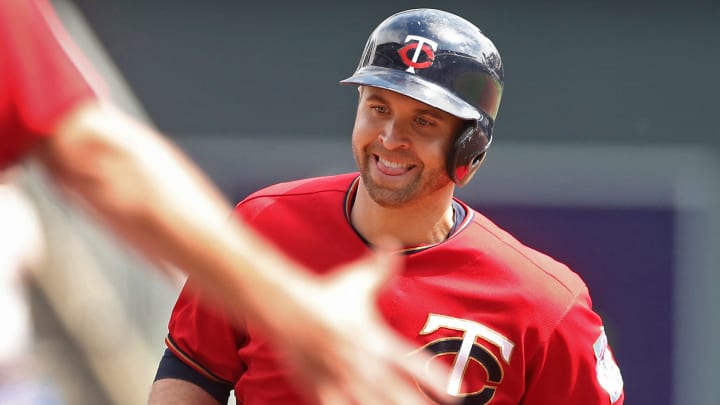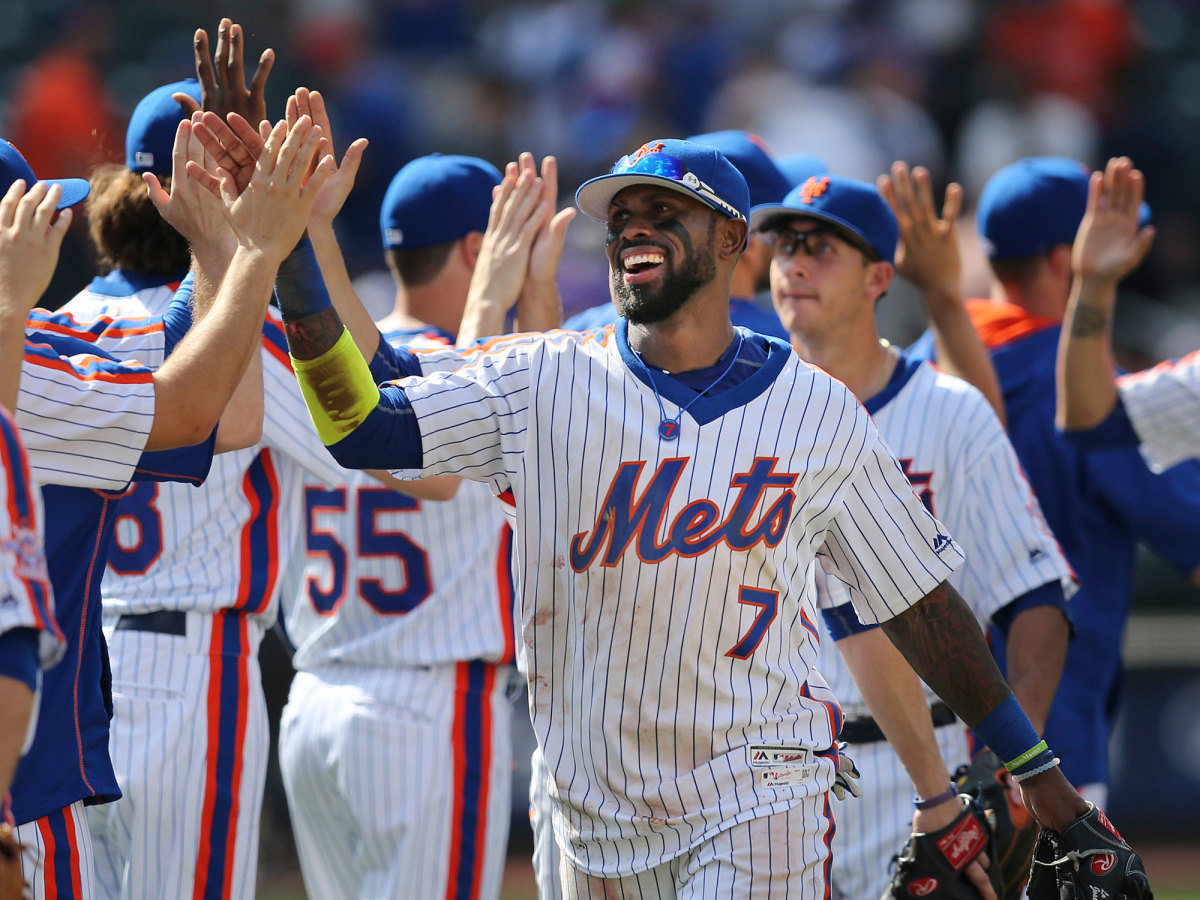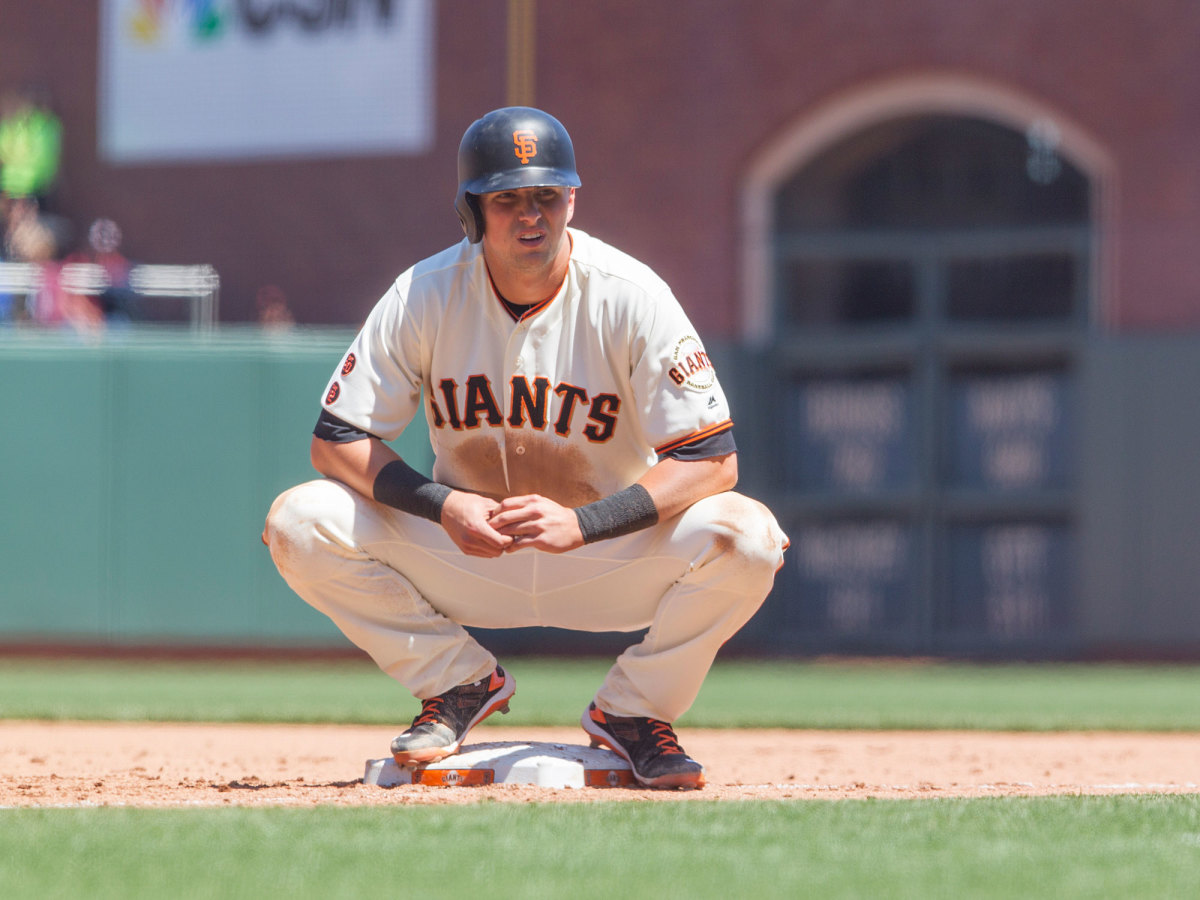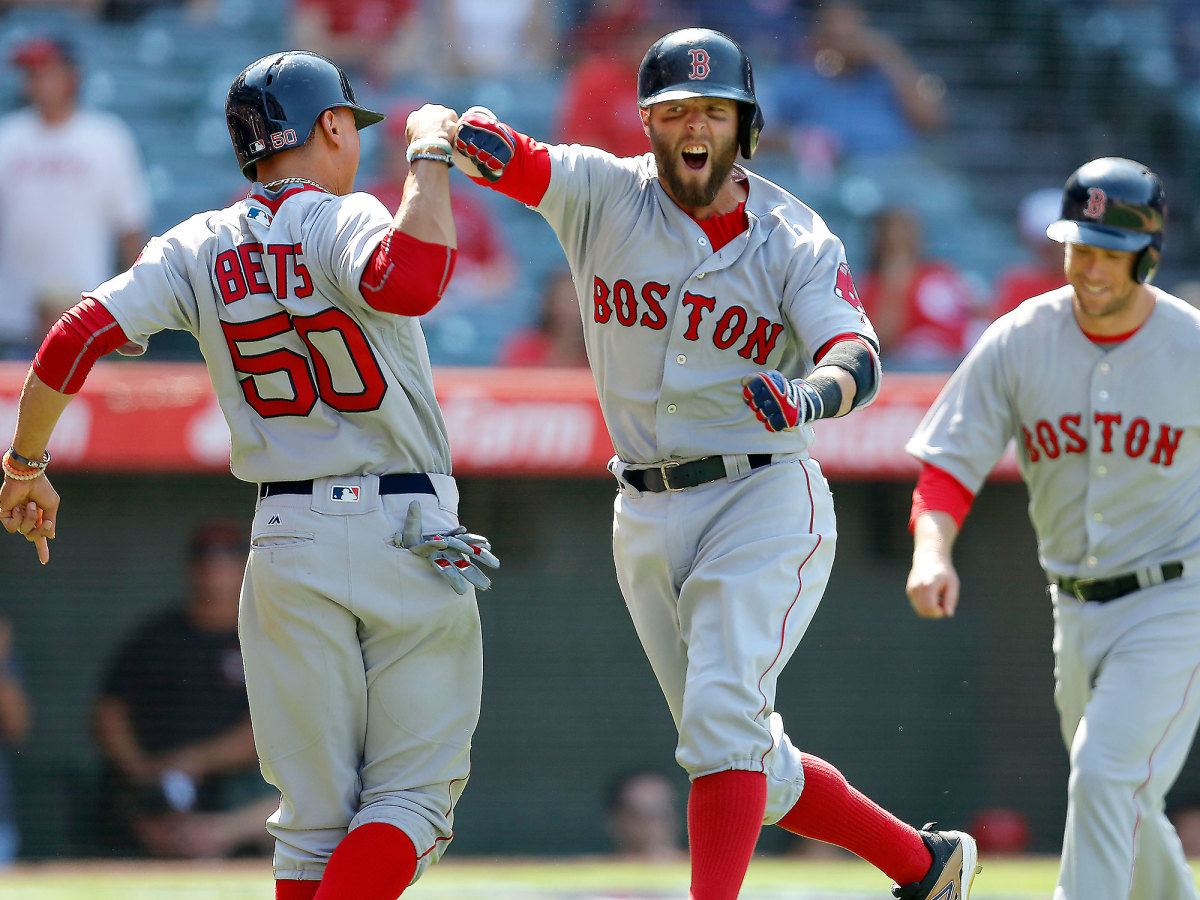The 30: Infielders who could decide who is in or out come October

In baseball, the smaller the sample of games, the more wacky things can happen. The playoff-contending Astros went a miserable 7-17 in April of this season, while the lowly Phillies surged to a 22-15 start before crashing back to Earth. With just four weeks left in the regular season, we could see all kinds of unexpected factors deciding playoff races.
For example: a group of second basemen playing huge roles in augmenting their own teams’ postseason chances, and potentially spoiling other teams’ hopes. Brian Dozier has been a beast on an otherwise awful Twins team. The injury-riddled Mets now must make do without Neil Walker. A surging Joe Panik tries to keep the swooning Giants in the mix. And Dustin Pedroia is on the tear of his life at just the right time for the Red Sox.
The deuce is loose. It’s Week 22 of The 30.
Best Moment That Will Make You Wonder Why It's Getting Dusty In Here: Eddie Gamboa
Eddie Gamboa was the longest of long shots. He was a 21st-round pick in a sport that very rarely grants chances to players with that modest a pedigree. He was a knuckleballer in an era where very few teams employ knuckleballers, or even pitching coaches qualified to help teach and refine it. At age 31, with nine years and 1,124 innings pitched in the minors, toiling at Triple A Durham, Gamboa seemed to be chasing the most futile of dreams.
Until he got the call. The kid who grew up watching Tom Candiotti with his dad to learn the art of the knuckler had finally made it.
Eddie Gamboa got his call to the big leagues after 9 years in the minors. #RaysOnDemand pic.twitter.com/0sGrU8tbav
— Tampa Bay Rays (@RaysBaseball) September 2, 2016
Granted, this wasn’t the first time Gamboa had earned a call to the Show. The Orioles also brought him up for a cup of coffee last year, but he never got into a game.
This time, his team wasted no time. Rays manager Kevin Cash summoned Gamboa from the bullpen last Friday night to face the heart of the Blue Jays order. It didn’t go particularly well, with Gamboa retiring just one of the four batters he faced, allowing a run, a hit, and two walks.
Still, no matter what happens from here, Gamboa can proudly proclaim one thing: Against all odds, his dream came true.

Silver Lining
Brian Dozier has been a rare bright spot for one of the worst teams in Twins history.
30. Minnesota Twins (51–88 record, minus-140 run differential, last week: 29)
29. Atlanta Braves (54–85, minus-146, LW: 30)
28. Cincinnati Reds (57–80, minus-124, LW: 25)
27. Arizona Diamondbacks (58–80, minus-146, LW: 28)
26. Oakland A’s (59–79, minus-121, LW: 26)
25. San Diego Padres (57–81, minus-87, LW: 24)
24. Philadelphia Phillies (62–76, minus-147, LW: 21)
23. Milwaukee Brewers (61–77, minus-68, LW: 27)
22. Tampa Bay Rays (58-79, minus-30, LW: 22)
21. Los Angeles Angels (62–76, minus-15, LW: 23)
Brian Dozier’s first two months of this season were a disaster. Minnesota's All-Star second baseman batted a brutal .202/.294/.329 through the end of May. With their best player hitting like a pitcher, it’s no surprise the Twins started 15-36 in that time.
Since then, however, Dozier has been one of the most terrifying hitters in baseball. In 88 games since June 1, he’s batting .315/.376/.701, with 34 home runs. He has now homered in five straight games, through Tuesday, and his 39 longballs this season have tied Alfonso Soriano's American League record for a second baseman. That’s an incredible surge, given where Dozier was just a few years ago. An eighth-round pick in the 2009 draft, he didn’t hit his first minor league homer until his 562nd plate appearance. Even when he earned the call to the majors, in 2012, talent evaluators praised his ability to hit line drives, but cautioned he likely would never be anything close to a real power hitter. Can’t nail 'em all.
Thanks to Dozier’s incredible surge, Minnesota has responded by going . . . 36-52. Hitting like peak Miguel Cabrera for three months doesn’t feel that great when your team is this bad. The 2016 Twins are now on pace for their worst season in 34 years. And while Dozier will present a nightmare matchup for contending opponents in the home stretch, many of his teammates have disappointed, setting up what could be the club’s first 100-loss season with that 60-102 debacle in 1982.
The top nine moments of my completely forgettable MLB career
With Dozier, Miguel Sano, Max Kepler and Byron Buxton offering hope for a lineup rife with youth and potential, the focus shifts to the pitching staff. The Twins rank dead last in the American League in ERA, as the only team with a mark above 5.00. Top pitching prospect Jose Berrios has been shelled in his first brush with the big leagues, and figures to need some time to harness his stuff and produce positive results in the majors. Finding a stable of promising arms to complement him could require years of shrewd drafting, spending some real money in free agency (like the $55 million they gave staff ace Ervin Santana before the 2015 season), or some all-time scouting acumen and luck in turning over the right rocks.
One last thing: Occasionally, a team will go a whole season producing aberrant results in individual innings. That team’s hitters will bunch hits together far more often than other squads, and/or have its pitchers scatter hits inordinately well to prevent big innings against them. Ed Feng, operator of an analytical site called The Power Rank, tracks this phenomenon every year, and calls it Cluster Luck. By that metric, the luckiest team in baseball last season was the Royals, the 2015 World Series winner that was 72 runs better than you’d expect given normal luck last year, and is now likely to miss the playoffs this year. Coming in second? The 2015 Cardinals, who were +67 runs by this metric, won 100 games last season and are fighting for their playoff lives in 2016.
Coming in third? The 2015 Twins, pegged by many as a surprise after their 83-79 season, but in retrospect more of a paper tiger that benefited from nearly 65 runs of good fortune. The rebuilding process continues. The team is reportedly considering former Blue Jays general manager Alex Anthopoulos for the same role in Minnesota. He, or anyone else who takes the gig, will need to be patient if the club is to recapture the success it had earlier this century, when it won six division titles in nine years from 2002 to '10.

Walking Wounded
A season-ending injury to their starting second baseman adds to an overcrowded disabled list, but the Mets remain in the thick of the wild-card race.
20. Chicago White Sox (66–72, minus-39, LW: 19)
19. Colorado Rockies (66–72, plus-28, LW: 20)
18. Miami Marlins (68–71, minus-9, LW: 17)
17. Pittsburgh Pirates (67–69, minus-14, LW: 14)
16. Seattle Mariners (70–68, plus-18, LW: 11)
15. Kansas City Royals (72–66, minus-3, LW: 15)
14. New York Yankees (72–65, minus-14, LW: 16)
13. New York Mets (73–66, plus-17, LW: 18)
The collection of talent on the Mets’ injured list is startling. All-Star starting pitcher Matt Harvey is out for the season. So is talented young righthander Zach Wheeler. Team captain David Wright probably won’t play again for the rest of the regular season, ditto for slugging first baseman Lucas Duda and backup outfielder Justin Ruggiano. Dynamic lefty Steven Matz is trying to come back from a shoulder injury that’s shelved him since mid-August, expert fly-chaser Juan Lagares has been out since late July with a thumb injury and swingman Jon Niese might need two more weeks (or longer) to return from minor knee surgery.
On Aug. 27 the Mets second baseman and second-best hitter, Neil Walker, cracked a home run and reached base four times in five trips to the plate. That was the last action he’s going to see this season, after back surgery knocked him out until next spring. That pileup of injuries would seem to be enough to eliminate most teams from a playoff race. Instead, the Swiss cheese Mets are getting hot at just the right time, with October baseball now a real possibility.
One of the team’s biggest catalysts has been Jose Reyes. A sub-replacement player last summer after the Blue Jays dumped him on the Rockies in the Troy Tulowitzki trade, Reyes’ loss of quickness and range made him no longer able to adequately play shortstop. And after a full season of lousy offensive numbers in Toronto and Colorado, followed by a two-month hiatus to start this year, he seemed unlikely to be much of an asset with the bat either. Desperate for reinforcements when the infield collapsed due to injuries, the Mets picked him up anyway, at the end of his two-month suspension for violating the league’s domestic violence policy. The move smacked of pointless nostalgia—for a time when Reyes was a better player who hadn’t been arrested for allegedly assaulting his wife.
Should fans accept Jose Reyes? Domestic violence experts weigh in
Instead, Reyes has become a much needed offensive contributor on a team that badly needed it, batting .284/.339/.469. And while he hasn’t dazzled at third base (where he’s played most often) or in a handful of games at short, he’s graded out as roughly league average or a small tick below in a small sample of 38 games, plenty good enough for a New York team that’s been bitten hard by the injury bug.
Sitting just a game out in the battle for the NL’s second wild-card spot qualifies as a minor miracle for the Mets, one helped along by Reyes, and also a red-hot shortstop; an unlikely hitting binge by a superutilityman; and a pair of out-of-nowhere rookie pitchers. As improbable as last season’s dash to the World Series was, a playoff berth this year might be even more amazin’.

Avoiding A Panik Pun
Even with their second baseman back and raking, the Giants are in trouble.
12. San Francisco Giants (74–64, plus-56, LW: 9)
11. St. Louis Cardinals (73–64, plus-81, LW: 13)
10. Houston Astros (74–64, plus-47, LW: 10)
9. Baltimore Orioles (76–62, plus-27, LW: 8)
8. Detroit Tigers (75–63, plus-23, LW: 12)
Two months from now, the Giants might look back at Labor Day as the turning point in their season.
Coming into Monday’s game, San Francisco had gone 16-30 since the All-Star break, the worst record in the league. In the history of the franchise, no Giants offense had ever gone more than four straight games with four hits or fewer. This year’s squad was now threatening to do so, having dropped three out of four to the Cubs while managing just 14 total hits in the series. The good news was that the Giants’ holiday matinee was happening at Coors Field, a perennial paradise for hitters. On the mound for the Rockies? Righthander Chad Bettis, who came into the game with a 5.17 ERA and 177 hits allowed in 153 1/3 innings pitched. If ever the conditions were ripe for a turnaround, this game was it.
Turns out, not so much. Bettis completely stymied San Francisco, tossing a two-hit shutout—just the second time in Coors Field history that a Rockies starter had thrown a complete-game shutout while allowing two hits or fewer. Even though the Giants rallied for a 3-2 win on Tuesday in which they picked up eight hits, they are still 17-31 in the second half, and after leading the NL West by eight games on June 26, they now trail the Dodgers by four. Moreover, San Francisco's lead over St. Louis in the wild-card race is down to just a half-game, with a bulge of just a game and a half over the Mets to hang onto even the second wild card.
Adrian Beltre, a home run ball and what happens when a journalist becomes a fan
Scarier still is that the Giants can no longer blame injuries for their woes. Their lineup was at one point severely short-handed, with key contributors Hunter Pence and Joe Panik the most prominent names on a crowded disabled list. Both have now been back for a while, though, and Panik has rediscovered the solid form he showed in 2015: Even counting the team’s brutal five-game stretch in which he went just 2-for-18, he is still hitting .301/.395/.534 over his past 21 games.
He just doesn’t have enough company. Matt Duffy tailed off sharply after a surprisingly strong 2015 rookie campaign, and Eduardo Nunez hasn’t hit much since being acquired to be Duffy’s replacement. Pence is on pace for his worst season since the Giants acquired him in 2012, while Denard Span’s numbers are the worst they’ve been since 2011. Buster Posey’s having the second-worst season of his career; San Francisco general manager Bobby Evans intimated at last week’s Pitch Talks that Posey had been playing hurt for much of the season, which has dinged his production. Add all those offensive downturns up and you have a team that struggled terribly to score runs for nearly two months straight.
Meanwhile, the bullpen’s been decent by some metrics but still leakier than we’ve seen in a while, led by Santiago Casilla leading the league in blown saves. And the back of the rotation has been a problem all year long, with Matt Cain and Jake Peavy pitching horribly and Matt Moore vacillating from a near-no-hitter to a six-run debacle at Coors on Monday.
The rotation is still led by two Cy Young contenders in Madison Bumgarner and Johnny Cueto, and the supporting cast is still good enough to squeak the team into the postseason—especially amid an uninspiring list of wild-card challengers. But if the Giants’ hitting luck doesn’t change soon, the hope that follows this ballclub every other year could get snuffed out in a hurry.

Who Are These Guys?
The Red Sox have swung from world-beaters to pushovers multiple times this season, creating even more intrigue in a heated AL East race.
7. Los Angeles Dodgers (78–60, plus-73, LW: 7)
6. Boston Red Sox (77–61, plus-146, LW: 6)
5. Toronto Blue Jays (77–61, plus-98, LW: 3)
4. Cleveland Indians (79–58, plus-99, LW: 4)
3. Texas Rangers (83–56, plus-26, LW: 5)
2. Washington Nationals (81–57, plus-142, LW: 2)
1. Chicago Cubs (89–49, plus-222, LW: 1)
It’s tough to think of any American League team looking better than the Red Sox did in their first two games against the A’s last weekend. On Friday, Boston crushed Oakland 16-2, followed by an 11-2 drubbing on Saturday. The offense looked exactly as formidable as you’d expect when it produces 27 runs in two games. With those two blowout wins, the Sox became the first team in American League history to score 10 or more runs against the same opponent five straight times.
Even more encouraging was the starting pitching. In the series opener, staff ace David Price fired seven innings of two-run ball, striking out seven and allowing four hits. After starting the year with a 6.75 ERA over his first seven starts, Price has since flashed a 3.13 mark over 22 outings, punching out 140 batters and walking just 32 in 149 1/3 innings. On Saturday, Rick Porcello was even stingier, ceding just four baserunners over seven innings and lowering his ERA to 3.23. After an ugly 2015 season made the four-year, $82.5 million extension the Red Sox gave him look like a disaster waiting to happen, Porcello is now a Cy Young candidate, and he looks like a veritable bargain compared to the giant deals handed to pitchers like Zack Greinke, not to mention even more embattled pitchers like Matt Cain.
Then just like that, the Red Sox couldn’t score a run to save their lives, falling 1-0 in a ninth-inning walkoff loss Sunday against the A’s, then losing to the lowly Padres and Edwin Jackson (EDWIN JACKSON!!!!) 2-1 on Monday. That four-game stretch was exceedingly weird, even by baseball standards.
Still, the formula’s not complicated here. Boston’s offense has been the best in baseball by a considerable margin pretty much all season long. Mookie Betts is a leading contender for AL MVP honors. David Ortiz might end up with the greatest farewell season for any hitter in major league history. Jackie Bradley Jr. and Xander Bogaerts are fulfilling the great potential that we’d heard discussed for years. Even supposedly fringe players like catcher Sandy Leon have absolutely raked.
If there’s an under-the-radar player in their midst, it might actually be the former Rookie of the Year and MVP winner, a two-time World Series champion and a four-time All-Star: Dustin Pedroia. In his past 25 games, the veteran second baseman has gone completely bananas, batting .443/.469/.509. When nearly half of the balls you put in play fall in for hits, that’s going to inflate your numbers, of course. Still, sustainable or not, Pedroia suddenly hitting like Rogers Hornsby atop the lineup has supercharged an already deadly Red Sox offense. Add electrifying rookie Yoan Moncada to the mix, with fellow rookie Andrew Benintendi potentially a couple weeks away from returning from a knee injury, and this could be one of the most exciting 1-through-9 lineups any team has fielded in years.
In-depth look at why Cubs have all the ingredients to end World Series drought
The problem is, all of that could be undone by the team’s Achilles heel: its bullpen. Though the Boston 'pen fares reasonably well by numbers like park-adjusted ERA, those metrics don’t tell the whole story. For one thing, some previously reliable arms have been awful lately, led by Junichi Tazawa, who has blown more games than fans would like to count before they could get to Craig Kimbrel for save opportunities. Fernando Abad was supposed to provide a reliable lefty arm to fortify that setup corps, but he too has scuffled, flashing a 5.73 ERA in 11 innings since coming over in a deadline trade with the Twins, with 18 baserunners allowed.
Many fans have taken to blaming manager John Farrell for the team’s lousy 16-20 record in one-games in particular. But when Tazawa, Abad, and others continue to pitch poorly, it puts the manager in a bad spot: He must choose between trusting a bunch of relievers who can’t currently be trusted to hold leads and keep games close, or hope that his starters can do the job instead.
Arguably the most frustrating two-game stretch of Boston’s season came Aug. 24 and 25 against the lowly Rays. In the first of those games, the Sox held a 3-2 lead heading into the eighth inning, only to watch Porcello give up a game-tying homer to Evan Longoria, followed three innings later by reliever Heath Hembree losing the game on a double, walk, and his own error. The very next day, the Sox headed to the seventh tied at 1-1, only to see Drew Pomeranz cough up the winning run on a double by Mikie Mahtook, who’d been a horrendous 0-for-34 until that at-bat. With no one to depend on ahead of Kimbrel, Farrell sent his starters deeper into the game, incurring the wrath of the third- and fourth-time-through-the-order penalties . . . and he paid the price for it.
As the Sox head into these final four weeks, they’re still well positioned to make the playoffs, either by holding onto a wild-card spot, or by winning the division, now that they're tied with the Blue Jays atop the AL East The offense is loaded, and Pomeranz and Eduardo Rodriguez have also pitched better lately, giving Boston a potentially excellent front four in its rotation. But few things can lead to losses, infuriate fans, and make a manager look bad than a bullpen that can’t get guys out.
With Dealin’ Dave Dombrowski having nabbed Kimbrel, Abad, Brad Ziegler, and Carson Smith over the past year and still being left with a shaky relief corps, and the trade deadline now behind us, there’s not much left for Sox fans to do but hope and pray that the bullpen can either do a better job or get spotted such huge leads that it doesn’t matter.
